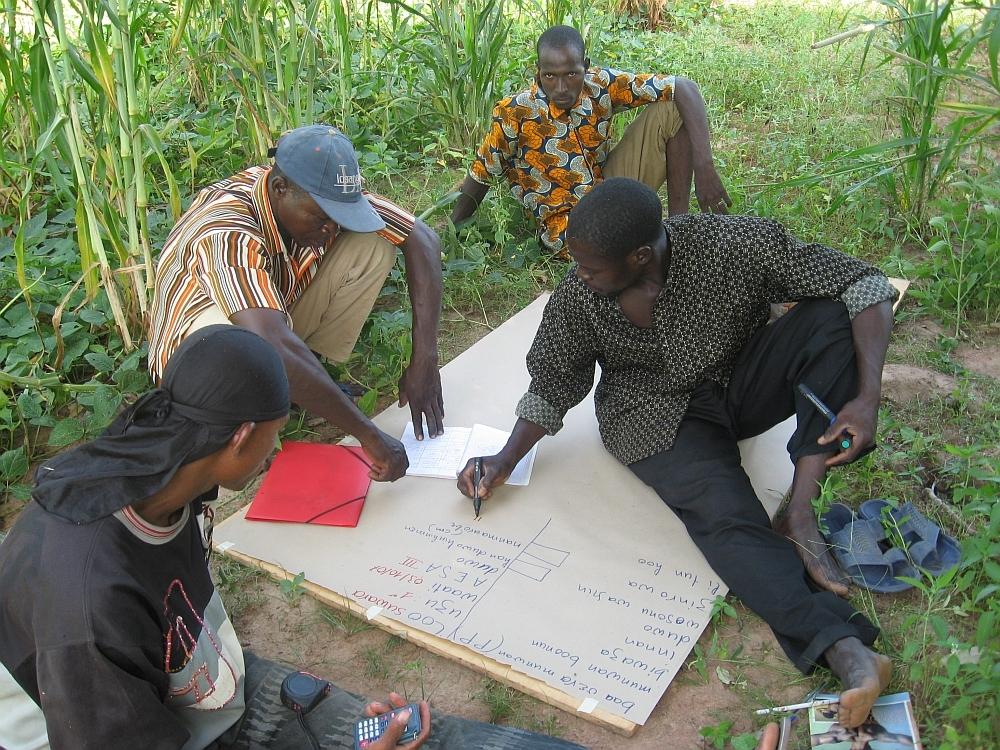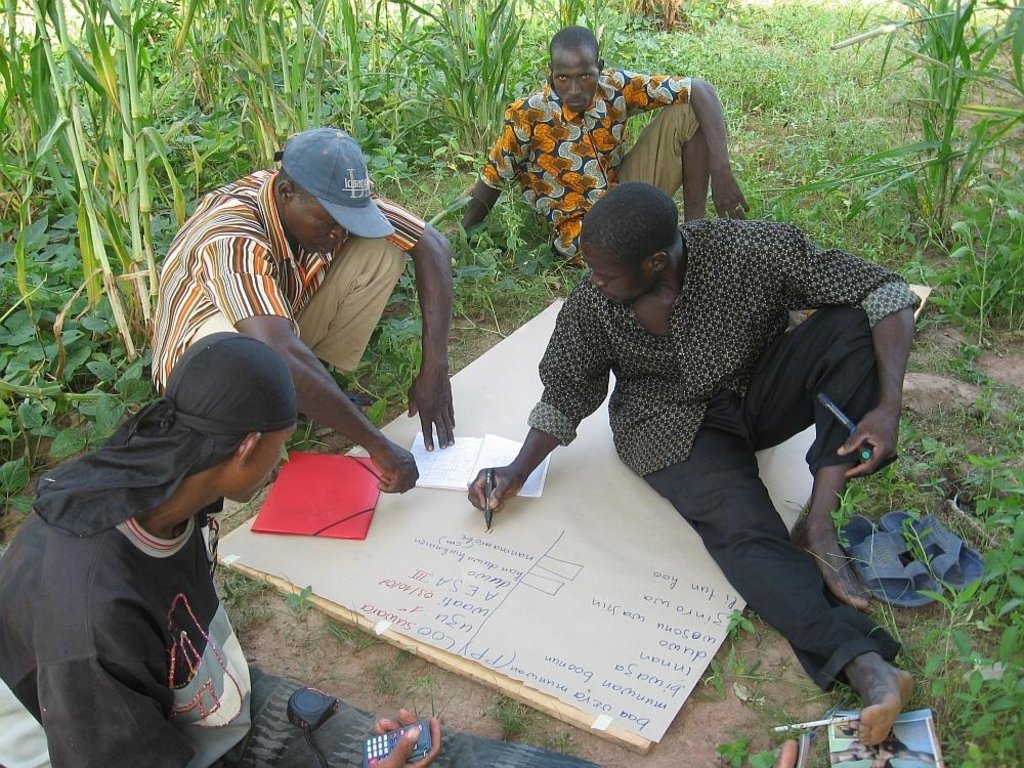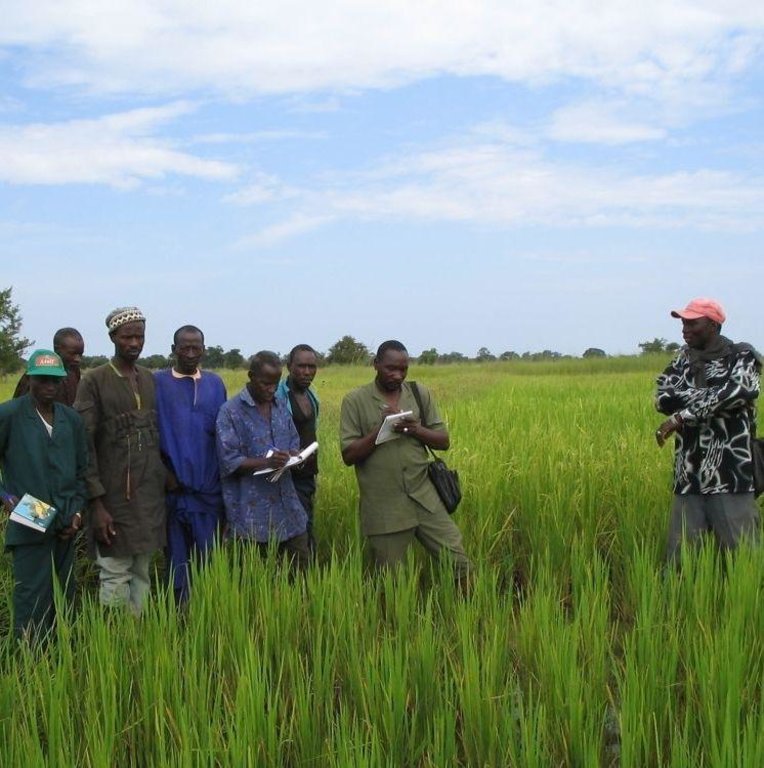Participatory Learning and Action Research for Integrated Rice Management (PLAR-IRM) [Мали]
- Создание:
- Обновить:
- Составитель: Dieter Nill
- Редактор: –
- Рецензент: Laura Ebneter
Apprentissage participatif/recherche-action pour la gestion intégrée du riz (French)
approaches_2502 - Мали
Просмотреть разделы
Развернуть все Свернуть все1. Общая информация
1.2 Контактные данные специалистов и организаций, участвующих в описании и оценке Подхода
Специалист по УЗП:
Guindo Idrissa
idrissa.guindo@helvetas.org
HELVETAS - Swiss Intercooperation
Мали
Специалист по УЗП:
Keita Lassana
lassana.keita@helvetas.org
HELVETAS - Swiss Intercooperation
Мали
Специалист по УЗП:
Dacko Maïga Rosaline
rosaline.dacko@helvetas.org
HELVETAS - Swiss Intercooperation
Мали
Название организации (-ий), содействовавших документированию/оценке Подхода (если применимо)
Deutsche Gesellschaft für Internationale Zusammenarbeit (GIZ) - ГерманияНазвание организации (-ий), содействовавших документированию/оценке Подхода (если применимо)
HELVETAS (Swiss Intercooperation)1.3 Условия, регламентирующие использование собранных ВОКАТ данных
Когда были собраны данные (на местах)?
01/07/2012
Составитель и ответственный/-ые специалист(-ы) согласны с условиями, регламентирующими использование собранных ВОКАТ данных:
Да
2. Описание Подхода УЗП
2.1 Краткое описание Подхода
An approach to develop farmers’ capacities to observe and analyse their rice management and growing practices; and to identify major constraints, then test, adapt and innovate with ways to improve integrated rice management.
2.2 Подробное описание Подхода
Подробное описание Подхода:
This is an educational approach for farmers, based around training groups of 20 to 25 adults and drawing on the experience of the farmers participating in the group. Farmers undertake their own analyses of the problems at hand and find their own solutions.
The PLAR-IRM approach comprises the following stages: Farmers start out by exchanging their knowledge, opinions, experiences and practices with each other and then observe crop behaviours. They compare, interpret, analyse and understand the causes for the differences observed. Next they weigh up the actions to be taken, testing new ideas and then putting them into practice. Farmers organise themselves (individually and as a group or community) to undertake the activities. Following this, functional networks are created with other farmers, extension/research services and any other support service. During the process, farmers’ learning and understanding is facilitated so that they can make better and more informed decisions, with the end goal of more productive and sustainable integrated rice management. The animators/facilitators use the learning tools provided in the PLAR-IRM training modules. These tools have been developed primarily to encourage farmers to exchange their experiences and to observe, reflect, analyse, conceptualise and test as a group. Many of the tools are based on the visualisation of phenomena and bring aspects to light that beneficiaries were previously unaware of. The 11 PLAR-IRM learning tools are: agricultural calendar, lowland area map, transect, plenary exchange session, the PLAR-IRM team’s introduction of new ideas, field observation in sub-groups, observation synthesis/Feedback, the IRM plot, trials, monitoring sheet, evaluation of gains.
Stages of implementation: 1)train the PLAR-IRM field teams, 2)devise projects for rolling out the PLAR-IRM approach more widely, 3)the approach calls for the intervention of specialist technical agents or technicians trained in PLAR-IRM, known as animators/facilitators, who help farmers to find their own solutions to problems and to increase their capacity for managing rice growing endeavours, 4)training sessions with farmers are very practical and are held in farmers’ fields. The facilitator prompts farmers to share their experiences and keeps lectures to a minimum. This stimulates farmers’ capacities to observe and interpret actions and to decide on the steps to take. Training sessions take place once a week. They begin around one month before the rice season starts and continue throughout the entire rice growing season, until after the harvest. Each session lasts one to two hours. Once the problem areas have been identified, farmers can try out new ideas. The facilitators help the farmers conduct simple trials to compare one or several new practices to their current techniques. Farmers agree among themselves on their objectives and the protocols to draw up. Practical sessions based around visits to field test sites give them the opportunity to carry out observations and adapt the new practices to their existing rice growing management context. The method is described in a manual (consisting of around 30 modules).
The lowland management committee organises teams and session calendars, and identifies plots. PLAR-IRM trainers plan modules and sessions, mobilise researchers, devise training content, conduct practical observation exercises, take notes and produce syntheses, and deploy evaluation tools for participatory learning. Farmers take part in the learning modules, apply the module learning in the field, carry out observations, contribute to decision-making, act on decisions made, perform monitoring and evaluation, and share their experience and expertise with others. The project team offers support, strategic organisation and coordination, liaises with local people, introduces the trainers, and contributes to the evaluation and capitalisation processes.
2.3 Фотографии, иллюстрирующие Подход
2.5 Страна/ регион/ место, где применялся Подход
Страна:
Мали
Административная единица (Район/Область):
Mali
Более точная привязка места:
Sikasso, Kayes, Ségou, Mopti
2.6 Даты начала и окончания реализации Подхода
Год начала реализации:
2003
2.8 Каковы цели/ задачи Подхода
The Approach focused mainly on SLM with other activities
The two main objectives of the technique are: 1)to develop farmers’ capacities to observe and analyse their rice management and growing practices; 2)to identify major constraints, then test, adapt and innovate with ways to improve integrated rice management.
The SLM Approach addressed the following problems: low rice production, lack of knowledge on different growing practices
2.9 Условия содействующие применению Технологии/ Технологий в рамках Подхода или затрудняющие его
Осведомленность в области УЗП, доступность технической поддержки
- затрудняют
lack of technical knowledge on different rice growing practices
Treatment through the SLM Approach: Farmers exchange their experiences. Technical agents or technicians trained in PLAR-IRM, known as animators/facilitators, help farmers to find their own solutions to problems and to increase their capacity for managing rice growing endeavours.
3. Участие и распределение ролей заинтересованных сторон
3.1 Заинтересованные стороны, участвующие в реализации Подхода и их роли
- местные землепользователи/ местные сообщества
- эксперты по УЗП/ сельскому хозяйству
- общественные организации
HELVETAS Swiss Intercooperation
- государственные власти (отвечающие за планирование или принятие решений)
3.2 Участие местных землепользователей/ местных сообществ на разных стадиях реализации Подхода
| Участие местных землепользователей/ местных сообществ | Перечислите участников и опишите их вовлеченность | |
|---|---|---|
| инициирование/ мотивация | интерактивное | |
| планирование | интерактивное | |
| выполнение | самоорганизация | |
| мониторинг/ оценка | самоорганизация | |
| Research | пассивное |
3.4 Принятие решений по выбору Технологии/ Технологий УЗП
Укажите, кто принимал решение по выбору применяемой Технологии/ Технологий:
- исключительно землепользователи (по собственной инициативе)
Поясните:
Farmers undertake their own analyses of the problems and find their own solutions.
Decisions on the method of implementing the SLM Technology were made by by land users alone (self-initiative / bottom-up)
4. Техническая поддержка, повышение компетенций и управление знаниями
4.1 Повышение компетенций/ обучение
Проводилось ли обучение землепользователей/ других заинтересованных лиц?
Да
Укажите, кто проходил обучение:
- землепользователи
- местный персонал/консультанты
Тип обучения:
- обмен опытом между фермерами
Рассматриваемые темы:
Training sessions with farmers are very practical and are held in farmers’ fields. The facilitator prompts farmers to share their experiences and keeps lectures to a minimum. This stimulates farmers’ capacities to observe and interpret actions and to decide on the steps to take. Training sessions take place once a week. They begin around one month before the rice season starts and continue throughout the entire rice growing season, until after the harvest. Each session lasts one to two hours. Once the problem areas have been identified (constraints), farmers can decide to try out new ideas.
4.2 Консультационные услуги
Есть ли у землепользователей возможность получать консультации?
Да
Укажите, где именно оказываются консультационные услуги:
- на полях землепользователей
Описание/ комментарий:
Name of method used for advisory service: animators/facilitators; Key elements: help farmers to find their own solutions to problems and to increase their capacity for managing rice growing endeavours, facilitator prompts farmers to share their experiences and keeps lectures to a minimum , facilitators help the farmers conduct simple trials to compare one or several new practices to their current techniques; PLAR-IRM trainers plan modules and sessions, mobilise researchers, devise training content, conduct practical observation exercises, take notes and produce syntheses, and deploy evaluation tools for participatory learning.
Advisory service is very adequate to ensure the continuation of land conservation activities
4.3 Институциональная (организационная) поддержка
В ходе реализации Подхода были ли организованы новые институциональные структуры или поддержаны уже существующие?
- да, существенно
Укажите уровень, на котором структуры были укреплены или вновь созданы:
- местные
Укажите тип поддержки:
- повышение компетенций/ обучение
4.4 Мониторинг и оценка
Являются ли мониторинг и оценка частью Подхода?
Да
Комментарии:
bio-physical aspects were ad hoc monitored by project staff, land users through measurements
technical aspects were ad hoc monitored by project staff, land users through observations
economic / production aspects were ad hoc monitored by project staff, land users through observations
economic / production aspects were ad hoc monitored by project staff, land users through measurements
management of Approach aspects were ad hoc monitored by project staff, land users through observations
bio-physical aspects were ad hoc monitored by project staff, land users through observations; indicators
There were no changes in the Approach as a result of monitoring and evaluation
There were no changes in the Technology as a result of monitoring and evaluation
4.5 Научные исследования
Были ли научные исследования частью Подхода?
Да
Укажите темы исследований:
- социология
- экономика / маркетинг
- экология
- технология
Напишите подробнее и назовите тех, кто выполнял исследования:
Research was carried out both on station and on-farm
5. Финансирование и внешняя материальная поддержка
5.2 Финансирование и внешняя материальная поддержка, предоставляемая землепользователям
Предоставлялась ли землепользователям финансовая/ материальная поддержка для применения Технологии /Технологий?
Нет
5.3 Субсидии на отдельные затраты (включая оплату труда)
- нет
Если труд землепользователя был существенным вкладом, укажите, был ли этот вклад:
- добровольный
6. Анализ влияния и заключительные положения
6.1 Влияние Подхода
Сумел ли Подход помочь землепользователям внедрить и поддерживать технологии УЗП?
- Нет
- Да, немного
- Да, умеренно
- Да, существенно
Farmers start out by exchanging their knowledge, opinions, experiences and practices with each other and then observe crop behaviours. They compare, interpret, analyse and understand the causes for the differences observed. Next they weigh up the actions to be taken, testing new ideas and then putting them into practice.
Сумел ли Подход расширить возможности социально и экономически уязвимых групп?
- Нет
- Да, немного
- Да, умеренно
- Да, существенно
Did other land users / projects adopt the Approach?
- Нет
- Да, немного
- Да, умеренно
- Да, существенно
PLAR-IRM has been rolled out in Mali, Benin, Togo, Guinea, Côte D’Ivoire, Ghana and the Gambia. In Mali, the practice has been applied in the regions of Sikasso, Kayes, Ségou and Mopti.
Did the Approach lead to improved livelihoods / human well-being?
- Нет
- Да, немного
- Да, умеренно
- Да, существенно
Increases in rice yields of between 25% and 40% can be achieved in lowland areas. Farmers’ rice-growing capacities are strengthened in terms of seeds, nurseries, plant care, irrigation, weed management, plant disease, harvesting, etc.
Did the Approach help to alleviate poverty?
- Нет
- Да, немного
- Да, умеренно
- Да, существенно
Increases in rice yields and farmers’ rice-growing capacities are strengthened
6.2 Основные причины, побуждающие землепользователей внедрять УЗП
- рост продуктивности
- рост прибыли (доходности) и рентабельности
- well-being and livelihoods improvement
6.3 Долгосрочная устойчивость мероприятий в рамках Подхода
Могут ли землепользователи самостоятельно (без внешней поддержки) продолжать применение того, что было реализовано в рамках Подхода?
- да
Если да, опишите как:
Farmers undertake their own analyses of the problems at hand and find their own solutions.
6.4 Сильные стороны/ преимущества Подхода
| Сильные стороны/ преимущества/ возможности по мнению составителя или других ключевых специалистов |
|---|
| Increases in rice yields of between 25% and 40% can be achieved in lowland areas. Farmers’ rice-growing capacities are strengthened in terms of seeds, nurseries, plant care, irrigation, weed management, plant disease, harvesting, etc. |
| The approach reinforces farming organisations’ endogenous capacities. A core of farmers master each session’s content and the PLAR-IRM modules. The method used is participatory and inclusive. Sessions are practical and take place in the field schools, which is particularly appealing to the farmers. (How to sustain/ enhance this strength: Motivating the teams of farmers is absolutely essential. Learning modules based on observation must be comprehensible and practical and delivered by competent deliverers and trainers. PLAR-IRM requires decisions made to be practical and immediately applicable. Researchers who are open to and respectful of local knowledge can facilitate the process.) |
7. Справочные материалы и ссылки
7.2 Ссылки на опубликованные материалы
Название, автор, год публикации, ISBN:
Manual of Good Practices in Small Scale Irrigation in the Sahel. Experiences from Mali. Published by GIZ in 2014.
Где опубликовано? Стоимость?
http://star-www.giz.de/starweb/giz/pub/servlet.starweb
Название, автор, год публикации, ISBN:
Defoer, T, Wopereis, M.C.S., Idinoba, P. and the PSSDRI/AKR team (2008): Curriculum d’apprentisage participatif et recherche action (APRA) pour la gestion intégrée de la culture de riz de bas-fonds (GIR) à Madagascar: Manuel du facilitateur [Participatory learning and action research (PLAR) curriculum for the integrated management of lowland rice growing (IRM) in Madagascar; Facilitator’s manual]
Где опубликовано? Стоимость?
Africa Rice Center, Cotonou, Benin and the Aga Khan Foundation, Geneva, Switzerland. http://www.africarice.org/publications/PLAR/madagascar/preface.pdf
Ссылки и модули
Развернуть все Свернуть всеСсылки
Нет ссылок
Модули
Нет модулей




